Everyone here warned me to replace at 100,000 miles. Because I didn't it cost me a $250 tow. It also cost me not using the AC Delco part, which most auto shops have to order. So, because I didn't listen I now have a fuel pump that could put me through all of this again in as little as a year. Take the advice of the wisdom here on this board and make changing your fuel pump a 100,000 mile general maintenance item. Also, if it's planned you have time to do other stuff under the vehicle because you're not as rushed.
The Astro and Safari vans use an electronic fuel pump that resides inside the gas tank. If your van strands you, and you don't hear the pump engage when you turn the ignition to the on position, it may just be your fuel pump. If you're close to home and yours dies, take a hammer or your tire iron and bang the bottom of your gas tank using an upward motion. Do this a few times and then have someone turn the key while you continue to do this. If you're lucky your van will start and stay running long enough to get you a short distance. By the way if that worked, you've pretty much confirmed a dead fuel sender assembly (fuel pump). Murphy's law says that if your pump dies and strands you, you must have a full gas tank. At least that's how it worked for me every time.
So, it begins. Safety Notes:
* Gasoline is extremely flammable, and volatile. Vapors can explode given a heat source or spark. Disconnect the battery before starting. If additional light is needed, do NOT use an open faced trouble light. Flashlights are a somewhat safer alternative.
* Crawling around underneath your vehicle often results in road dirt and rust falling, usually finding its way into your eye. Safety glasses are good, a face shield is better—this would the second time my van sent me to an optometrist to look at my eye...
* Additionally, gasoline can contain carcinogens—it's not all just straight chain octane, though that is one of the goals of refining it. Nitrile gloves aren't a bad good idea, and good ventilation is a must—this is a good one for the driveway instead of the garage.
Start by siphoning gasoline out of the tank. I couldn't get a hose into the tank through the gas filler tube (where you insert a gas nozzle to fuel up), because something kept blocking it. So my procedure will involve doing it without the gas filler tube attached. Try to siphon through that first, though.
The only way to access the fuel pump is to remove the gas tank. Stuff attached to the gas tank has 3 fuel lines and 3 sensor wires. Additionally, the gas tank is held in place by two straps. Your gasoline filler tube (where you insert a gas nozzle to fuel up) is attached, and is not part of the tank. Start by removing it. The gas filler tube is attached to the side of the van by two small bolts (7 mm on my 03). shown below:
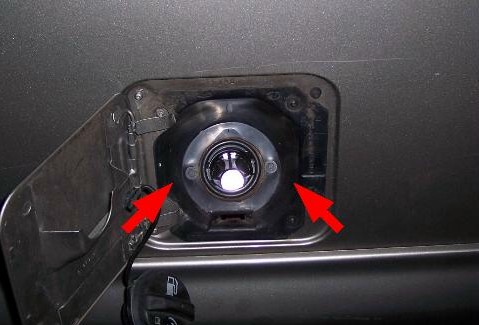
The filler tube also has a bracket, underneath the van. If memory serves me, it's a 13 mm bolt on my 03. Unbolt it.
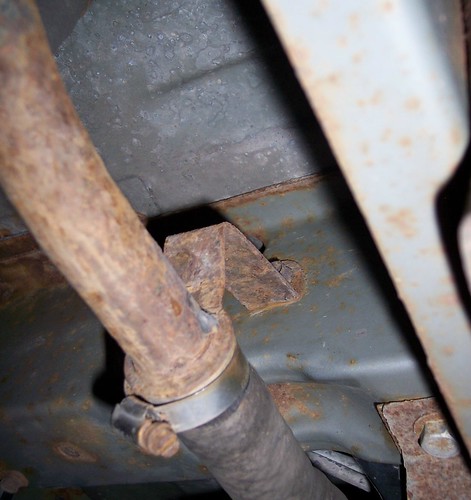
Lift and the back end of the van and then loosen the clamps on the hose connecting the oil filler tube to the gas tank and remove the gas filler tube from the gas tank—if you can't fit the a screwdriver in there to do it, they are probably 5/16” bolts.
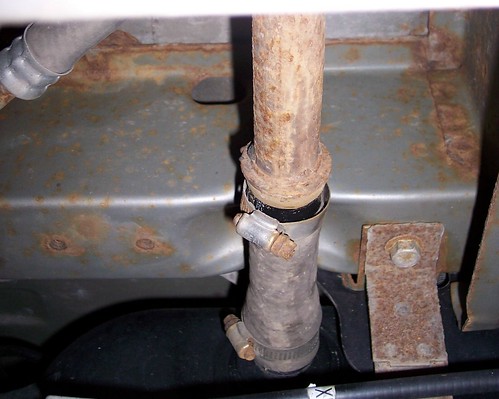
Pull the gas filler tube off of the gas tank and remove the gas filler tube from the van. See all that rust on it? Now might be a good time to wire brush it, sand it a little and hit it with some black rustoleum. If not already done, siphon any gas out of the tank. You may need to round up the neighborhood's gas cans for this one.
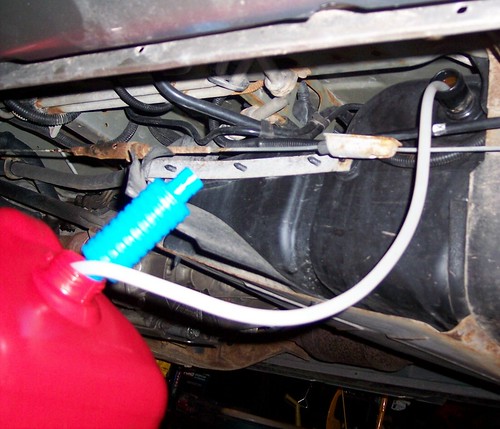
This will take a while if you had a full tank. Have a beer or do something else to pass the time, while keeping half an eye on the can so it doesn't overflow...
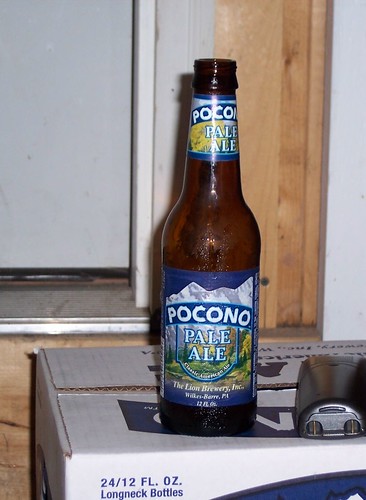
Okay now that the tank is drained, you can start at removing all of the wiring harnesses and fuel lines connected to the gas tank. Service manuals tell you to disconnect the EVAP purge line and the related sensor wires.
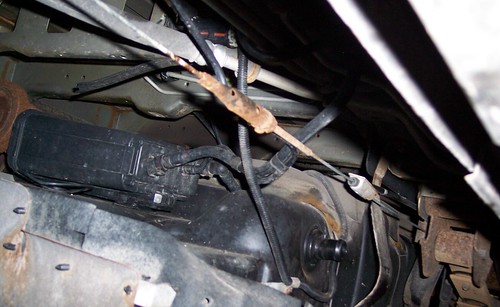
You could do that, and it works well for any shop that does this repair I'm sure. Here's another idea. See the assembly in the upper part of the photo below? Disconnect the wiring harness from that, than simply unbolt the assembly from the side of the van. No fuel lines disconnected... Probably no more difficult, but it just shows there's more than one way to skin a cat.
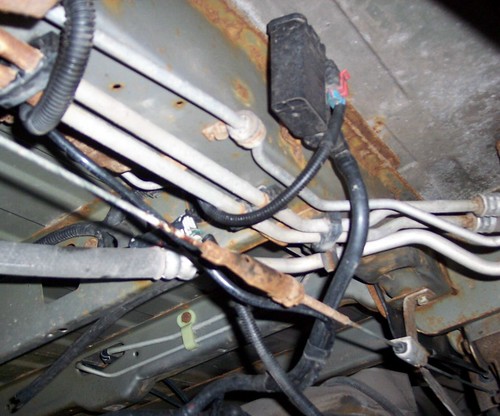
If you can reach them, there are two fuel lines between the gas tank and the drive shaft (coming from the fuel pump). No photos because I couldn't see them. If you can't reach them, don't sweat it. You're saving an enormous amount of money doing this yourself as it is, and I believe that these lines should be lengthened so that they're long enough to drop the tank, and then be disconnected. In their current form, they're not. So if you can't reach them, and kink them while dropping the tank, get yourself a 5/16” and a 3/8” fuel line repair kit (contains one PVC line with one quick connector and an barbed fitting to go onto the non-kinked part of your hose). The lines will be a little longer for next time. Only thing is you must be careful to keep the lines away from the muffler when re-installing the tank.
You'll want to detach the wiring from the side of the fuel tank. This is the wiring going into the fuel pump. It will be hooked on the side of the tank to keep it from dangling when you drive—unhook it.
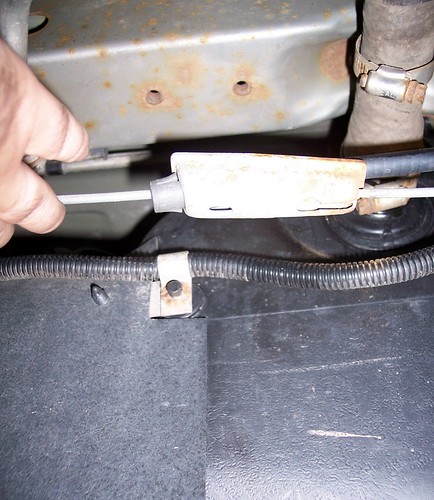
Now support the gas tank with a jack—try to off center it slightly toward back of vehicle for balance, and begin to loosen the tank straps.
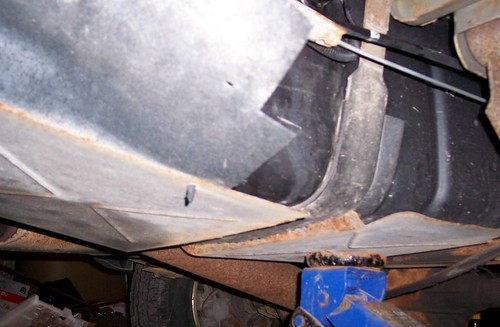
Next start to loosen the bolts on the tanks straps. If memory serves me, these are 15 mm bolts. You'll need socket extensions with this as well. Loosen the strap bolts on the drivers side. Remove the strap bolts on the passenger side.
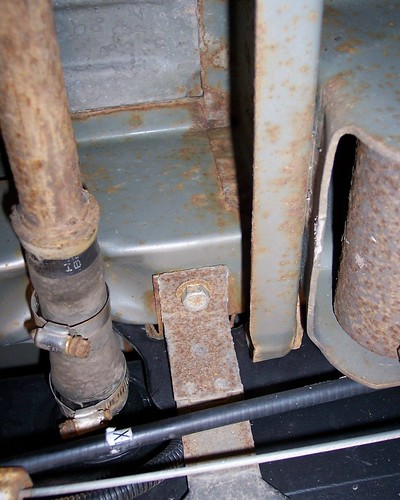
Now slowly release tension on the jack to lower the tank, slowly. If you couldn't reach those fuel lines off of the pump, you'll be able give yourself one more chance before you kink them. Additionally, remove the two wiring harnesses attached to the fuel pump.
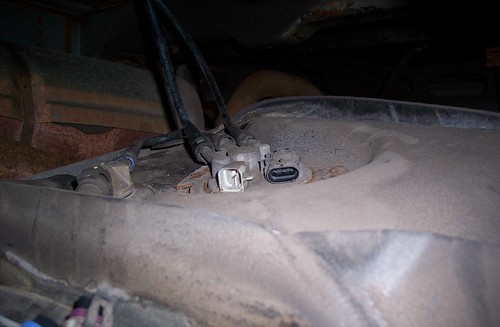
Now drop the tank to the ground and pull it out from under the vehicle. Remove all fuel lines from the fuel pump. I used a small screwdriver and my fingers to depress the plastic clips retaining them.
Your fuel pump will probably be held in by a retaining ring that has to be unscrewed. GM has a fuel sender wrench just for removing this. I didn't need one, and you probably don't either. What you do need is a can of PB Blaster or some other liquid wrench type of stuff, patience, a hammer, and a brass drift. There are some model years of these vans that require use of snap ring pliers or a right angle pick instead of the brass drift. If yours doesn't look much like this, and has holes in it, you'll need to use snap ring pliers instead. If it looks like below, use liquid wrench and a brass drift striking at the points and directions of the arrows as shown below. You may need to let the liquid wrench soak in a while—idea: spray it liberally, have a beer, spray again then use brass drift. Before you do this, note the direction of the fuel pump inlet and outlets (install new one facing same way).

Once that ring turns free, your going to lift the old pump (fuel sender assembly) out, tilting as needed to get gas guage float out. No photos of this, sorry. Clean the retaining ring a little if you like. Be careful not to get dirt from outside your tank in if you can. Remove and replace the old seal ring between the fuel pump and tank. Then place in the new fuel pump (fuel sender assembly) and replace the retaining ring. Then replace the center line on the pump.
Edit Note: Be very carefull of the fuel pump float when placing in the new one. You don't want your van to show empty on the gas guage all of the time. Also, depending on model year, if your van reads nothing from that sensor, it may not start, regardless of how full your tank really is. I know this because mine had this issue when it was still under warrenty.
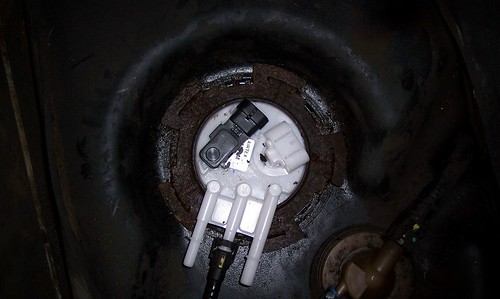
Replace the gas filler tube, going in the reverse of how you removed it—you did get that rust off it right?

Push tank back under vehicle and replace all fuel lines, placing them on the pump first. If you cut the lines as I did and used a line repair kit to lengthen them, you'll be able to attach them to the vehicle's hard lines as well. Place wiring harnesses back onto the fuel pump. Edit Note: Remember that if you did this, you need to be especially carefull to keep them away from the muffler when raising the tank.
NOTE: You may have to replace one of the wiring harnesses—I did. All you need is wire cutters, electrical tape, and a crimping tool—although I think needle nose pliers would work too... It's easy. Follow the directions that came with the wiring harness to the letter—it would have come with the fuel pump if you need to do this. Sorry, no pics or procedure. Simply cut the 4 wires, placing cuts at least 1.5” from each other. Strip about 5/16" or so off each of the wires, and line them up with the new harness. Cut and strip harness wires to fit. Use the included clips to splice the wires or twist together and use electrical tape—the included clips are better to use. Wrap everything with electrical tape when done.
Replace the gas tank—that will likely be a 2 person job, but I did it myself by pulling the tank on top of myself and wrangling it into place. Here's a tip, remember to bring the tank strap bolts and your socket/ratchet with you. I didn't remember the first time... Replace straps and bolts—but leave them loose until you re-attach the fuel pump lines to the hard lines above it if you have not already done this.
Replace everything else you did, working in reverse order.
Put some gas in the tank and start it.
If anyone sees anything I might have missed please reply and mention it. Also, if anyone has any pics of the fuel pump with snap ring in place, please reply and post them.







